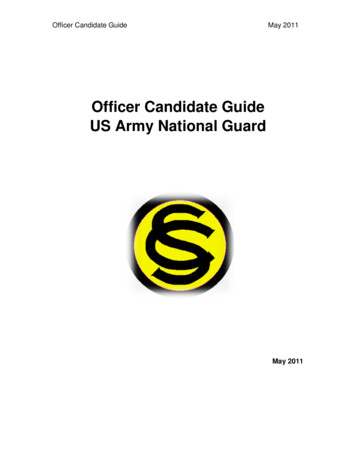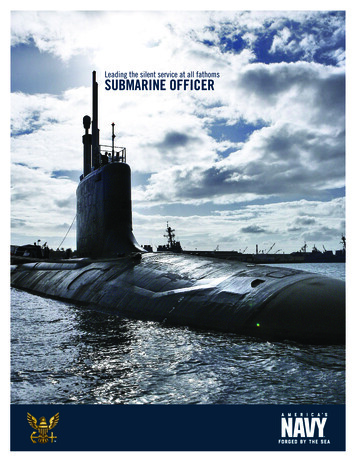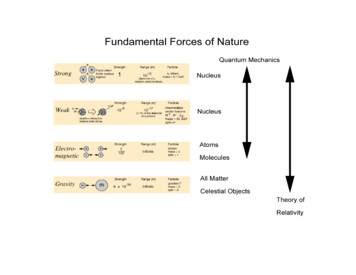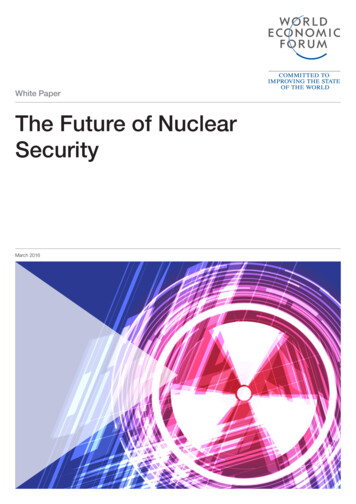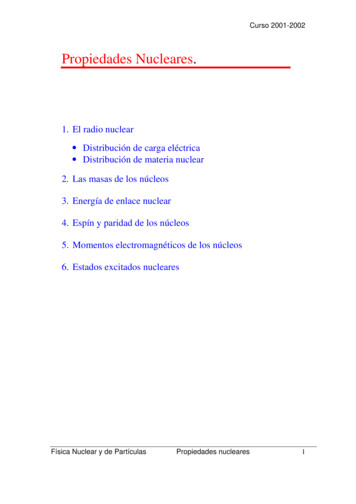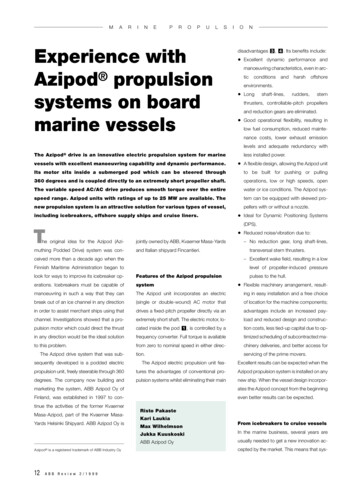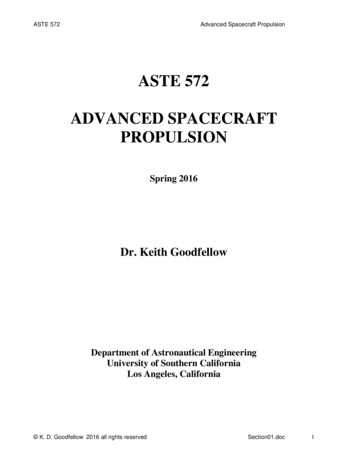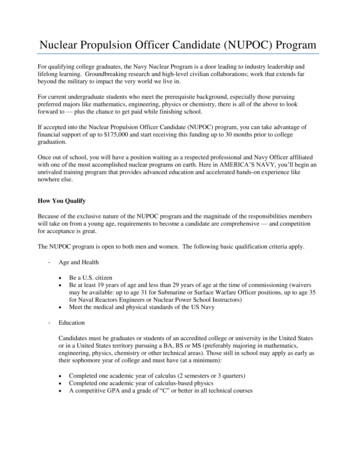
Transcription
Nuclear Propulsion Officer Candidate (NUPOC) ProgramFor qualifying college graduates, the Navy Nuclear Program is a door leading to industry leadership andlifelong learning. Groundbreaking research and high-level civilian collaborations; work that extends farbeyond the military to impact the very world we live in.For current undergraduate students who meet the prerequisite background, especially those pursuingpreferred majors like mathematics, engineering, physics or chemistry, there is all of the above to lookforward to — plus the chance to get paid while finishing school.If accepted into the Nuclear Propulsion Officer Candidate (NUPOC) program, you can take advantage offinancial support of up to 175,000 and start receiving this funding up to 30 months prior to collegegraduation.Once out of school, you will have a position waiting as a respected professional and Navy Officer affiliatedwith one of the most accomplished nuclear programs on earth. Here in AMERICA’S NAVY, you’ll begin anunrivaled training program that provides advanced education and accelerated hands-on experience likenowhere else.How You QualifyBecause of the exclusive nature of the NUPOC program and the magnitude of the responsibilities memberswill take on from a young age, requirements to become a candidate are comprehensive — and competitionfor acceptance is great.The NUPOC program is open to both men and women. The following basic qualification criteria apply.-Age and Health -Be a U.S. citizenBe at least 19 years of age and less than 29 years of age at the time of commissioning (waiversmay be available: up to age 31 for Submarine or Surface Warfare Officer positions, up to age 35for Naval Reactors Engineers or Nuclear Power School Instructors)Meet the medical and physical standards of the US NavyEducationCandidates must be graduates or students of an accredited college or university in the United Statesor in a United States territory pursuing a BA, BS or MS (preferably majoring in mathematics,engineering, physics, chemistry or other technical areas). Those still in school may apply as early astheir sophomore year of college and must have (at a minimum): Completed one academic year of calculus (2 semesters or 3 quarters)Completed one academic year of calculus-based physicsA competitive GPA and a grade of “C” or better in all technical courses
VIP TourIf you’re a qualified Nuclear Propulsion Officer candidate, the Navy offers a two-day VIP trip that allowsyou to immerse yourself in this world. Tour the flight deck of an aircraft carrier, walk through the torpedoroom of a submarine, sit in a class at Nuclear Power School, or see engineers at work at the nuclear Navyheadquarters. Interact with current and prospective Officers and ask questions. Learn about the rich history ofthe Navy and its nuclear program. This is a chance to learn firsthand what it may be like to launch yourfuture as a Nuclear Officer in the Navy.NUPOC InterviewAll students who apply to the NUPOC program go through a rigorous screening process and are then selectedfor a personal interview with the Director of Naval Reactors in Washington, D.C.The first part of the interview process focuses on technical questions from calculus, physics and othertechnical courses. The majority of the questions are from calculus and physics, and you may be askedquestions from other topics in your major. This part of the interview process typically lasts 45–60 minutesand contains three to five major questions per interview.The second part of the interview process involves meeting with Admiral John M. Richardson, the currentdirector of the Naval Nuclear Propulsion program. During this interview, he will review your transcripts andthe evaluations from your technical interviews, and he will assess your communication skills, interests andmotivation for the program. Admiral Richardson personally selects all Navy Nuclear Officers.Offers for StudentsThe NUPOC program culminates in a career opportunity that is without equal. But the immediate financialrewards that can be gained as a student are impressive on a whole other scale.While finishing your degree, you could receive a monthly salary and housing allowance that ranges from 3,990 to 6,000 (housing allowance may vary depending upon location, and the length of the offer dependsupon the career area you plan to enter). Now do the math.Submarine Officers, Surface Warfare Officers and Power School Instructors: The NUPOC offer is currentlyavailable for up to 30 months prior to college graduation — making it worth up to 175,000 to you as astudent.Naval Reactors Engineers: The NUPOC offer is currently available for up to 18 months prior to collegegraduation — making it potentially worth up to 95,000 to you as a student.Use the money to cover tuition and books, to pay rent or buy a car, to purchase meals or whatever you want.It is there to allow students the freedom to focus on studies while in school. There are no requirements towear a uniform or attend military training during this time. All you have to do is maintain the required gradepoint average and prepare for the exciting future that’s waiting.
The Added BonusesOn top of the monthly income, NUPOC students are also eligible for military health-care and life insurancebenefits for themselves and their dependents while in the program. Additionally, their issued military ID willallow access to low-cost shopping options on military bases.Those who opt to pursue Fleet leadership roles as nuclear-trained Submarine or Surface Warfare Officers arealso eligible to receive: A 15,000 selection bonus once accepted into the NUPOC program.An additional 2,000 bonus upon completion of nuclear propulsion training (which occurs aftergraduating from college).Officer TrainingUpon college graduation, the formal training process for becoming a Navy Officer in the Naval NuclearPropulsion Program is officially underway.-Officer Candidate School (OCS)For those going the Submarine or Surface Warfare Officer route, the first step is OfficerCandidate School (OCS) — a 12-week course in Newport, Rhode Island. OCS is tailored totrain and prepare college graduates to become commissioned as Navy Line Officers —specifically, Submarine and Surface Warfare Officers (as well as Navy Aviators, FlightOfficers, Special Warfare and Special Operations Officers). Officer Candidates obtain moreresponsibility as their training progresses and are eventually given command authority overother Officer Candidates. During the 12 weeks, individuals gradually move fromIndoctrination Candidates to Officer Candidates to Candidate Officers.Officer Candidates are assigned to battalions at the Newport Naval Station. During their 12week training period they are instructed on leadership, physical and military training, as wellas academics, ranging from Navigation to Shipboard Engineering and Damage Control. Eachcandidate is also assigned a Chief Petty Officer and a commissioned Naval Officer to aid inhis/her transformation from civilian to Candidate Officer. Candidates are also rigorouslytrained by Marine Corps Drill Instructors who challenge them on every physical level.-Officer Development School (ODS)For those pursuing Naval Reactors Engineer or Nuclear Power School Instructor roles, thefirst step is Officer Development School (ODS) — a five-week course in Newport, RhodeIsland. ODS is tailored to train already-commissioned Officers to become staff corpsOfficers — specifically, Naval Reactors Engineers and Power School Instructors (as well asMedical Corps, Medical Service Corps, Dental Corps, Nurse Corps, JAG Corps, andChaplain Corps Officers).While not as lengthy as its OCS counterpart, ODS still heavily stresses physical and mentalreadiness. The course offers newly commissioned Officers a comprehensive and intenseintroduction to their responsibilities as Navy staff corps Officers. Over the course of fiveweeks, Officers learn about the military structure of the United States Navy, its rich historyof traditions and customs, leadership development, and military etiquette. ODS is also
physically demanding, though its requirements focus more on basic maintenance training,whereas OCS training is much more accelerated.Unique Training PathsOnce commissioned as an Officer, candidates move on to receive the advanced training that is at the core ofthe Naval Nuclear Propulsion Program. Academically, the curriculum is recognized as one of the mostdifficult in the world — rivaling the top-notch nuclear programs at universities such as Harvard and MIT.Experientially, the hands-on application of what is learned is in a class by itself.-Submarine Officer Job Overview:When it comes to upholding national security, the U.S. Submarine Force provides pivotalservice by deterring conflict through stealth, intelligence, surveillance, reconnaissance, andthe use of its powerful offensive capabilities. If you have the strength, ambition, anddiscipline to be part of an elite group of leaders, rise to your life’s challenge by becoming aSubmarine Officer. Job Description:Only a select group of disciplined and committed Officers are given the opportunity to leadan entire crew and command some of the most technologically advanced equipment in theworld. Submarines are the cornerstone of the Navy’s conflict avoidance and resolution, andnaturally, the Officers who man these ships are held to the highest of standards and haveextraordinary roles and responsibilities.Much of the initial time Submarine Officers spend on board is devoted to learning andoverseeing the day-to-day operations of a nuclear-powered submarine. Upon mastering thisoperation, junior Officers learn more about communications, navigation, armamentcapabilities, and the tactical deployment of the submarine.Submarine Officers command, manage, and operate the Fleet’s attack, ballistic missile andguided missile submarines, as well as ensure that all the ship’s systems run smoothly —from atmosphere control and nuclear propulsion systems to fire control and weaponssystems. They may also be in charge of the safe operation of a nuclear reactor, maintainingtheir ship’s weapons, charting the ship’s position and operating communications andintelligence equipment.Whether on a covert, classified mission or a typical day of operation, Submarine Officersgain valuable lifelong experiences, advanced nuclear training and a sense of responsibility.These responsibilities provide unique experiences in leadership and in managing people andtime — attributes beneficial in either a career within the Navy or in the civilian sector.Submarines, their Officers, and their crews are heavily relied upon for antisubmarinewarfare, anti-surface warfare, land attack, strategic deterrence, and landing Special Warfareforces, to name but a few of the many exciting missions. Standards for submariners are veryhigh, and operations are often covert and classified. During a sea tour, Submarine Officersmay be in charge of any number of tasks, including the safe operation of the nuclear reactor;
maintaining the ship’s torpedoes, cruise missiles, ballistic missiles, and sonar; charting theship’s position; and operating communications and intelligence equipment. As a SubmarineOfficer, you will be specially trained in the nuclear field and assigned to a nuclear-poweredattack submarine, fleet ballistic missile submarine, or guided missile submarine. oAttack Submarines: Designed to pursue and attack enemy surface ships and submarines.They are the most effective antisubmarine warfare tool available to counter enemydiesel- and nuclear-powered submarines. They also conduct many other missions, suchas intelligence, surveillance, and reconnaissance.oFleet Ballistic Missile Submarines: These submarines are almost two football fields longand carry long-range missiles. With their nuclear reactors and stealth, they are alwaysready should a situation arise needing their firepower.oGuided Missile Submarines: High-payload submarines armed with tactical missiles andthe ability to employ Special Operations Forces in support of Naval and joint operations.Career Outlook and Progression:Training as a Submarine Officer directly translates to civilian careers in executive-levelmanagement, as well as the technology industry and high-tech specialty systems. Thespecialized knowledge and expertise you could gain through Navy nuclear training willprovide you with a skill set that is sought after worldwide. You will gain important insightsfrom your international travels, which will be invaluable to employers in the private sector.Upon completion of Officer Candidate School (OCS), newly commissioned SubmarineOfficers can expect an advanced training process that includes classroom study, fieldexperience and the application of their comprehensive training in settings at sea and ashore.Naval Nuclear Power School (NNPS): Through Naval Nuclear Power Training Command(NNPTC), Officers will attend Nuke Power School in Charleston, South Carolina. This 24week graduate-level course of intensive study covers a variety of science and technologybased subjects from ordinary and partial differential equations to thermodynamics to reactordynamics. NNPS provides the foundation of knowledge necessary for a theoreticalunderstanding of nuclear propulsion.Nuclear Power Training Unit (NPTU): Often referred to as Prototype, this 26-week phase ofthe learning process involves hands-on training at one of two NPTUs — in either Charleston,South Carolina, or Ballston Spa, New York — where there are several reactor prototypes inoperation. Here, Officers apply the concepts learned at Nuke Power School — studyingsystems and components of a nuclear propulsion plant and working with all the associatedsystems of a full-scale operating plant. The training culminates with qualification asEngineering Officer of the Watch.Submarine Officer Basic Course (SOBC): During this 12-week course that takes place inNew London, Connecticut, Officers learn all about submarine operations, including safety,damage control, seamanship and the responsibilities of leading an advanced submarine crewas a division Officer, before reporting to an assigned submarine. Officers may receive anadditional six weeks of advanced training through the strategic weapons system course atTrident Training Facilities in either Kings Bay, Georgia, or Bangor, Washington.First Sea Tour: Next comes an assignment as a division Officer on a submarine, managing ateam of highly trained Enlisted Submariners. Here, Officers are working toward a personalsubmarine qualification program that culminates in being designated as “Qualified in
Submarines” — earning the right to wear the coveted Gold Dolphins insignia and take on allthe responsibilities that go with it. This is a three-year tour alternating between deployments,patrols, days in port, maintenance, local operations, and leave.Shore Assignment: Upon After the first sea tour comes a shore assignment lastingapproximately two years. In this role, Officers fill positions anywhere from Nuke PowerSchool to Prototype to Submarine School. Others may be selected to serve on high-levelstaffs, commands and strategic projects, or they may elect to work in recruitment positionsor further their education at Naval Postgraduate School (NPS). If selected for DepartmentHead, Submarine Officers may sign another contract and continue their Naval career. Theultimate goal for many: to one day command their own submarine. -Special Pay/Bonuses:As a nuclear-trained Officer, you’ll benefit from some of the most rigorous training theNavy has to offer. Your hard work is not only rewarded with an excellent salary, but you’llalso receive generous bonuses. Submarine Officers are eligible for sea pay and submarineduty pay. Additionally, Nuclear Officer Continuation bonus is currently 30K/year for eachyear after the initial 5-year contract.Surface Warfare Officer Job Overview:Upon The U.S. Navy operates some of the world’s most technically advanced equipment,the mainstay of which is a vast fleet of aircraft carriers, cruisers, destroyers, frigates, docklanding ships and other surface vessels. These ships and their crews are commanded andmanaged by a top-notch group of drivers and fighters — the Navy’s Surface WarfareOfficers (SWOs). If you have the ability to take charge and have strong leadership skills,take command of your future as a Surface Warfare Officer trained in the fundamentals ofnuclear propulsion. Job Description:While Surface Warfare Officers (SWOs) are involved in nearly every aspect of a Navymission, their ultimate goal and primary focus is to command a Navy surface ship. Thehighly specialized nuclear training SWOs receive prepares them to lead the Navy’s nuclearpowered vessels. While aboard the world’s most powerful warships, these intelligent, goaldriven individuals manage other Sailors to successfully maintain and operate the ship’ssystems.While at sea, Surface Warfare Officers are in charge of numerous shipboard operations andactivities, ranging from anti-air, submarine and surface warfare support to supplyingcombatant ships with fuel, ammunition and food to providing repair, maintenance and rescuecapabilities through fleet support ships. Aboard multimillion-dollar aircraft carriers, theyalso provide and coordinate air defense, as well as transport vehicles, cargo and troops.Throughout their time on board a ship, Surface Warfare Officers are put in charge of adivision and are responsible for ensuring that the people in their division remain highlyfunctional. What’s more, it is their responsibility that equipment runs smoothly and that allrequired tasks are completed on time to ensure that the ship is mission-ready as scheduled.These day-to-day tasks lead to an incredible lifelong sense of responsibility for mostOfficers.
Surface Warfare Officers receive valuable nuclear training that often directly transfers tocivilian careers in executive-level management as well as many technology and high-techspecialty systems. Proof positive that their ability to command leads to a lifetime of successand respect. Career Outlook and Progression:Upon completion of Officer Candidate School (OCS), newly commissioned Surface WarfareOfficers can expect an advanced training process that includes classroom study, fieldexperience and the application of their comprehensive training in settings at sea and ashore.Surface Warfare Officer School (SWOS): During this 20-week course that takes place inNewport, Rhode Island, Officers learn all about surface force combat systems, tacticalconcepts, propulsion systems (gas, turbine, diesel and steam), maneuvering, navigation,personnel administration, shipboard organization and the responsibilities of leading teams ofSailors as a division Officer before reporting to an assigned conventional surface ship.First Sea Tour: Next comes assignment as a division Officer on a conventional surface ship,commanding a team of Sailors responsible for a certain component of the ship — anythingfrom electronics to weapons to engineering systems. Here, Officers are working towardSurface Warfare qualification — earning the right to wear the coveted Surface WarfareOfficer insignia and taking on all the responsibilities that go with it. This is an 18-month touralternating between deployments, patrols, days in port, maintenance, local operations andleave.Naval Nuclear Power School (NNPS): Same as Submarine OfficersNuclear Power Training Unit (NPTU): Same as Submarine OfficersSecond sea tour: With proven abilities as a Surface Warfare Officer on a conventional shipand nuclear training, the next assignment is as a division Officer in the engineering plant of anuclear-powered aircraft carrier. This is an 18-month tour alternating between deployments,patrols, days in port, maintenance, local operations and leave.Shore assignment: After completing their sea tours, Surface Warfare Officers may fillpositions anywhere from Nuke Power School to Prototype to Submarine School. Others maybe selected to serve on high-level staffs, commands and strategic projects, or they may electto work in recruitment positions or further their education at Naval Postgraduate School(NPGS). If selected for Department Head, Surface Warfare (Nuclear) Officers may signanother contract and continue their Naval careers. The ultimate goal for many: to one daycommand their own ship. Special Pay/Bonuses:As a nuclear-trained Officer, you’ll benefit from some of the most rigorous training the Navyhas to offer. Your hard work is not only rewarded with an excellent salary, but you’ll alsoreceive generous bonuses. Surface Warfare (Nuclear) Officers are eligible for sea pay.Additionally, Nuclear Officer Continuation bonus is currently 30K/year and SurfaceWarfare Officer Continuation Pay is currently 15K/year for each year after the initial 5-yearcontract.
-Naval Reactors Engineer Job Overview:For Naval Reactors Engineers, the future is now. Responsible for designing, maintaining andoperating the world’s most advanced reactor plants, Reactors Engineers stay ahead of thecurve in order to remain on the cutting edge of nuclear propulsion at all times. If you like totake control and stay at the forefront of technology, a career as a Naval Reactors Engineercould be ideal for you. Job Description:Some of the brightest minds the Navy has to offer work at Naval Reactors (NR) inWashington, D.C., as Engineers. Their intelligence, backgrounds and extensive trainingprovide them with an impressive knowledge of all aspects of nuclear propulsion, as well asthe flexibility to move into other technical areas involved in nuclear propulsion work.Simply put, the Naval Reactors Engineers are the best of the best.While at junior level, Naval Reactors Engineers assume responsibility for various portions oftechnical work in a variety of state-of-the-art facilities, including two Department of Energylaboratories, six shipyards, two nuclear prototype/training sites, more than 100 nuclearpowered ships, and more than 1,000 firms that support the Naval Reactors Program. It’s thisfirsthand, on-the-job training that provides them the knowledge needed to excel in theNavy’s rapid-paced nuclear propulsion field.Typically in charge of several projects at once, Naval Reactors Engineers take part in anumber of technical disciplines. They design nuclear reactors and their components. Theydevelop and implement operating, maintenance and refueling procedures for nuclearpropulsion plants. They oversee the acquisition, construction, testing and operation of theseplants. They sail aboard nuclear-powered vessels and observe propulsion plant performance.No area goes untouched.Much like the nuclear propulsion field, the working environment at NR is both challengingand rewarding. All Engineers selected for NR assignment are at the top of their class,making up a workforce consisting of the best and brightest technical experts in the country.The attributes acquired at NR are invaluable and will lead to a successful future, whether inthe military or the private sector. Few careers can make that claim. Career Outlook and Progression:Upon completion of Officer Development School (ODS), newly commissioned NavalReactors Engineers can expect to spend the next five years overseeing all the shipboardnuclear power plants, shore-based prototypes and nuclear propulsion support facilities in theNavy. The advanced training process they undergo prepares them to join some of the bestand brightest technical experts in the country.Naval Reactors Headquarters (NR) — Preliminary Training: Officers have an initialassignment of approximately four to five months receiving preliminary training at the NavalReactors Headquarters in Washington, D.C. This is followed by approximately two weeksspent gaining a working background at one of the Navy’s land-based prototypes in eitherCharleston, South Carolina, or Albany, New York.
Naval Reactors Training Program (NRTP): The next step involves the six-month process ofearning a postgraduate-level education in nuclear engineering through the Bettis ReactorEngineering School at the Bettis Atomic Power Laboratory in Pittsburgh, Pennsylvania.Naval Reactors Headquarters (NR) — Staff Assignment: Following Naval ReactorsTraining, Naval Reactors Engineers are then assigned a Nuclear Engineer position with thegroup responsible for managing all technical aspects of the Navy Nuclear PropulsionProgram — planning, approving and confirming the design, operation and maintenance ofover 100 nuclear reactors. Engineers start in a junior role under a supervisor and rapidlyadvance to take on more and more responsibilities. If selected for Engineering Duty Officer,NR Engineers can sign another contract and continue their Naval careers.-Nuclear Power School Instructor Job Overview:The brilliant minds of the Navy Nuclear Program work in complex ways, seeminglywith the greatest of ease. Shaping these individuals are Nuclear Power SchoolInstructors, whose job is to teach nuclear-trained Officers and Enlisted personnel thetheories and fundamentals behind the design and operation of Navy nuclear propulsionplants. If teaching is your calling and you want to be part of one of the most prestigiouscommunities in the world today, consider a career as a Naval Nuclear Power SchoolInstructor. Job Description:Atomic physics. Thermodynamics. Integral calculus. For many, the sheer thought of thesesubjects gives reason to shudder. However, for the bright young minds of the Navy NuclearProgram, these things come easily — thanks to the superb, thorough teaching provided byNuclear Power School Instructors.Today’s Power School Instructors train the future Navy nuclear community through atechnologically advanced curriculum. From mathematics to physics, chemistry to reactordynamics and electrical engineering, the subject matter is as intense as it is challenging. Andall taught with a sole purpose in mind: to prepare Nuclear Officers for their work in the fastpaced, competitive nuclear power field.Nuclear Power School is a 24-week course in science and technology, designed to providetheoretical background knowledge of nuclear power. Nuclear Power Instructors providedetailed knowledge of a pressurized-water Navy nuclear power plant, its reactor core nuclearprinciples, heat transfer and fluid systems, plant chemistry and materials, mechanical andelectrical systems, and radiological control. Typically, there is one instructor per subject onduty each academic night, allowing students requiring additional assistance on theirhomework or studies to call upon them at any time.For years, the Naval Nuclear Power School has been widely regarded as one of the mostdifficult academic programs in the country. At the heart of this program are the extraordinaryinstructors who shape the equally extraordinary minds of future Nuclear Officers. And whilethe course work they teach may be fast-paced and the standards they set may be high, theresults Nuclear Power Instructors get in return are worth it.
Career Outlook and Progression:Upon completion of Officer Development School (ODS), newly commissioned PowerSchool Instructors can expect to spend the next four years teaching future nuclear-trainedOfficers and Enlisted personnel the theory and fundamentals behind the design and operationof Navy nuclear propulsion plants. But first, they must undergo the same advancedcurriculum and training that they will expertly instruct.Through Naval Nuclear Power Training Command (NNPTC), Officers attend Nuke PowerSchool in Charleston, South Carolina. This four-month comprehensive course of intensivestudy in science and technology provides the foundation of knowledge necessary for atheoretical understanding of nuclear propulsion.While at NNPS, Officers assume an intense workload. The subjects covered at NNPSinclude: Mathematics (39 hours) — Ordinary and partial differential equations,integral calculus, and probability and distribution functions.Physics (71 hours) — Atomic and nuclear physics, special relativity, reactorphysics and neutron diffusion theory.Chemistry (50 hours) — Basic chemistry, reaction kinetics, boiler chemistry,radiation induced reactions, gases and oxidation-reduction.Thermodynamics (87 hours) — Heat transfer, fluid dynamics, steamthermodynamics, properties of water, Rankine cycle, and conduction andconvection.Electrical Engineering (basic and advanced — 138 hours) — Circuit analysis,inductance and capacitance, solid state amplifiers, AC and DC motors andgenerators, digital and analog integrated circuits, reactor plantinstrumentation, safety circuits, and reactor control equipment design.Materials (28 hours) — Strength of materials and complete development ofthe Nil Ductility Phenomenon. Fuel and clad alloy composition, pressurevessel design, development of neutron embrittlement and other materialradiation effects, as well as corrosion and structure of materials.Reactor Dynamics and Core Characteristics (86 hours) — Complete coredesign satisfying all requirements for power, temperature, control andradiation levels. Essentially, a course in nuclear engineering.Reactor Plant Systems (13 hours) — Design of steam system and reactorplant parameters.Shielding and Radiological Fundamentals (46 hours) — Study of materials,attenuation factors and geometry in shielding calculations.Aspects of Reactor Plant Operations (115 hours) — Study of reactor plantoperations integrating knowledge from all of the above courses.Upon completion of NNPS, the student becomes the teacher. Power School Instructors thentake the lead in administering the technologically advanced curriculum, working closelywith both the Officer and Enlisted personnel who come through their classrooms.
NUCLEAR PROPULSIONOFFICER CANDIDATEUCLARANK1BASE SALARY:OC1 (E-6) 2,546.40OCC (E-7) 2,944.2TAX-FREE ALLOWANCES:FOOD (BAS)HOUSING (BAH) SINGLE 369.39 2,658.00 369.39 2,748.00MONT
Medical Corps, Medical Service Corps, Dental Corps, Nurse Corps, JAG Corps, and Chaplain Corps Officers). While not as lengthy as its OCS counterpart, ODS still heavily stresses physical and mental readiness. The course offers newly commissioned Officers a comprehensive and intense introduction to their responsibilities as Navy staff corps .

